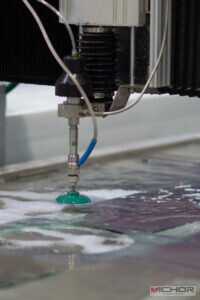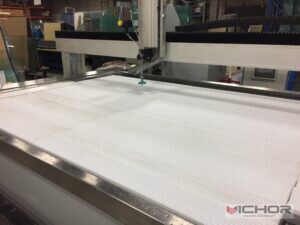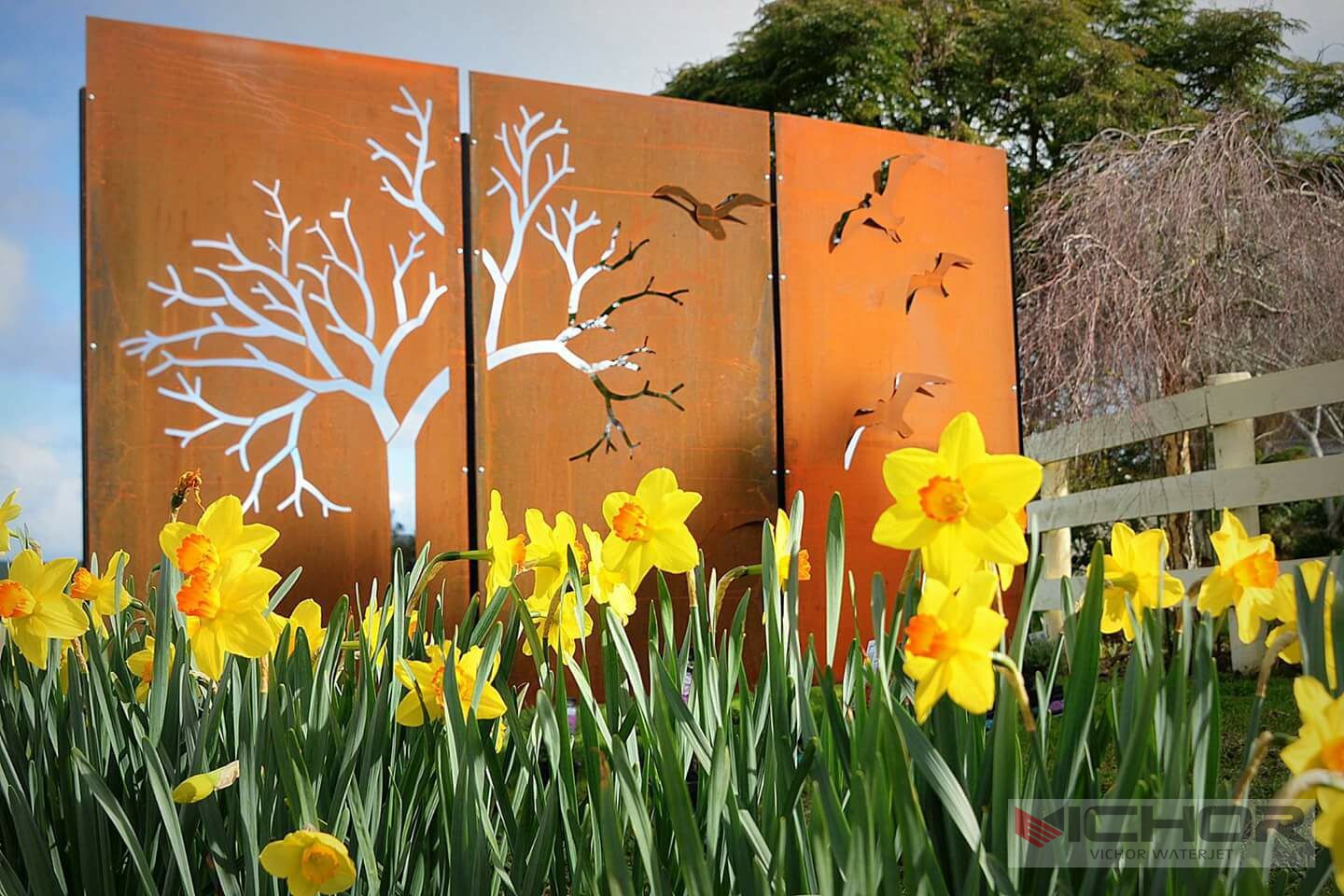
The Ultimate Guide to Water Jet Stone Cutting Machines: Precision, Versatility & Innovation
In the demanding world of stone fabrication and design, achieving intricate cuts, flawless edges, and complex shapes without compromising the material’s integrity is paramount. This is where water jet stone cutting machine technology shines. Utilizing the immense power of ultra-high-pressure water, often mixed with abrasive garnet, these machines offer unparalleled capabilities for cutting stone. This comprehensive guide delves into the world of water jet stone cutting machines, exploring their workings, advantages, applications, selection criteria, and future potential. Whether you’re a seasoned stone fabricator, an architect, or an artist, understanding this transformative technology is essential.
What is a Water Jet Stone Cutting Machine & How Does It Work?
At its core, a water jet stone cutting machine is a computer-controlled (CNC) system that directs a highly pressurized stream of water, or water mixed with abrasive particles, through a tiny nozzle to erode and cut through solid materials like stone. The process is fundamentally cold-cutting, generating no heat-affected zones, which is crucial for materials sensitive to thermal stress like granite, marble, or quartzite.
Ultra-High Pressure Generation: The heart of the system is an intensifier pump or a direct drive pump. These pumps take regular tap water (or filtered water) and pressurize it to extreme levels, typically between 50,000 PSI (3,400 bar) and 90,000 PSI (6,200 bar). This pressurized water is stored in special accumulators to ensure a consistent flow.
The Jewel Orifice: The pressurized water is forced through a tiny, precision-made jewel orifice (often made of diamond or sapphire), typically ranging from 0.010″ to 0.015″ (0.25mm to 0.38mm) in diameter. This transforms the high-pressure water into an incredibly focused, supersonic stream.
Abrasive Introduction (For Abrasive Waterjet – AWJ): For cutting hard materials like stone, pure waterjet (PWJ) lacks the necessary cutting force. Therefore, an abrasive material (almost always specially graded garnet) is introduced into the water stream within a mixing chamber located just downstream of the orifice. The high-velocity water stream creates a vacuum that draws in the abrasive, accelerating the garnet particles to near the speed of the water itself.
Focusing Tube: The mixture of water and abrasive then travels through a long, narrow tube called a focusing tube or nozzle (usually made of tungsten carbide or composite diamond). This tube concentrates the abrasive stream, further increasing its cutting power and coherence.
Material Erosion: The resulting abrasive-laden waterjet strikes the stone surface with tremendous kinetic energy. The hard garnet particles microscopically erode the stone material along the precisely controlled path dictated by the CNC system. The water serves primarily to accelerate the abrasives and flush away the eroded particles (slurry) from the cut kerf.
CNC Motion Control: The cutting head, containing the orifice, mixing chamber, and focusing tube, is mounted on a sophisticated X-Y (and often Z-axis for taper compensation or 3D cutting) gantry system. This gantry moves the cutting head accurately over the stone slab according to the digital design file (e.g., DXF, DWG), enabling the creation of highly complex shapes.
Key Advantages of Using a Water Jet Stone Cutting Machine
The adoption of water jet stone cutting machine technology offers a multitude of benefits over traditional stone cutting methods like diamond saws, routers, or wire saws:
Cold Cutting Process: The single most significant advantage. No heat is generated during cutting. This eliminates:
Heat-Affected Zones (HAZ): Prevents micro-fractures, changes in material structure, and thermal stress that can weaken the stone or cause delayed cracking, especially critical near edges and intricate details.
Material Warping/Distortion: Ensures dimensional stability and flatness.
Harmful Fumes/Dust: Avoids the toxic dust and fumes produced by hot cutting methods (though waterjet produces slurry mist that needs extraction).
Unmatched Precision and Complexity: CNC control allows for exceptional accuracy (typically within ±0.005″ or 0.13mm) and repeatability. Water jet stone cutting machines excel at cutting intricate designs, sharp inside corners, curves, bevels, holes, and lettering that are impossible or extremely difficult and time-consuming with mechanical tools. They essentially function like a very precise, cold “saw” capable of any 2D shape.
Minimal Material Waste (Kerf): The cutting kerf (the width of material removed by the jet) is very narrow, typically ranging from 0.030″ to 0.050″ (0.76mm to 1.27mm), depending on the nozzle size and material thickness. This significantly reduces material waste compared to wider diamond blades, maximizing yield from expensive stone slabs – a major cost-saving factor.
Versatility Across Stone Types: A single water jet stone cutting machine can cut virtually any type of natural or engineered stone: granite, marble, limestone, travertine, sandstone, slate, onyx, quartzite, soapstone, engineered quartz (like Caesarstone or Silestone), terrazzo, and even highly brittle or laminated stones that would shatter under mechanical stress or heat.
No Mechanical Stress/Vibration: The cutting force is localized and very precise. There’s no significant mechanical pressure or vibration exerted on the stone slab, unlike sawing or milling. This is crucial for cutting fragile stones, thin materials, or near existing cutouts.
Edge Quality: Produces smooth, clean edges, often requiring minimal secondary finishing (honing or polishing) depending on the stone type and desired finish. The cut edge is typically square or has minimal taper.
Reduced Set-Up Time: Changing from cutting one stone type or design to another primarily involves loading a new digital file and potentially adjusting abrasive feed rate/pressure, not swapping physical blades or bits.
Primary Applications in the Stone Industry
The unique capabilities of the water jet stone cutting machine have revolutionized numerous aspects of stone work:
Intricate Countertops & Vanity Tops: Cutting complex sink cutouts (including undermount sinks with perfect reveals), faucet holes, drain boards, curved edges, integrated drain grooves, and unique backsplash shapes with unmatched precision and no risk of thermal damage, especially critical near sink cutouts.

Custom Tiles & Mosaics: Creating unique geometric patterns, borders, medallions, logos, and artistic inlays from various stone types. Perfect for high-end residential and commercial flooring and wall features.
Architectural Elements & Cladding: Precision cutting of stone for complex facades, curved walls, column covers, window surrounds, and decorative panels.
Monuments, Memorials & Lettering: Cutting highly detailed inscriptions, portraits, religious symbols, and complex shapes for headstones and memorials with crisp, clean edges.
Artistic Sculptures & Decorative Pieces: Enabling artists and designers to realize complex 2D and 3D stone sculptures, wall art, furniture components, and bespoke decorative items that were previously unachievable.
Specialized Industrial Components: Manufacturing precise stone parts for machinery bases, bearings (historically), wear surfaces, and other industrial applications requiring dimensional accuracy.
Repair & Modification: Accurately cutting patches or making modifications to existing stone installations without damaging surrounding areas.
Choosing the Right Water Jet Stone Cutting Machine: Key Considerations
Selecting the optimal water jet stone cutting machine requires careful evaluation of several factors:
Machine Size (Cutting Envelope): Determine the maximum dimensions (length x width) of the stone slabs you typically work with. Machines range from smaller tabletop models (e.g., 4′ x 4′) to large industrial systems capable of handling slabs over 10′ x 5′ or larger. Consider future needs as well.
Pump Type and Pressure:
Intensifier Pumps: Most common in stone cutting. Use hydraulic oil to drive a piston that pressurizes water. Offer very high pressures (60k-90k+ PSI), excellent for thick, hard stone but can have slightly more pulsation. Robust and reliable.
Direct Drive Pumps: Use an electric motor coupled directly to the pump crankshaft. Typically operate at 50k-60k PSI. Often quieter, with smoother water flow and potentially lower operating costs for certain applications, but may have limitations on maximum pressure for the hardest/thickest stones.
Higher pressure generally allows faster cutting of thick/hard materials but increases wear part costs.
Abrasive Delivery System: Reliable and consistent abrasive metering is crucial for cut quality and efficiency. Look for systems with large hoppers (reducing refill frequency), precise flow control, and minimal clogging potential.
Motion System & Accuracy:
Gantry Construction: Heavy-duty, rigid construction (e.g., welded steel) minimizes vibration and deflection during cutting, ensuring accuracy.
Drive Systems: Servo motors and precision ball screws or rack-and-pinion drives offer high speed and accuracy. Linear guides should be robust.
Positioning Accuracy/Repeatability: Crucial for intricate work and nesting parts efficiently. Look for specifications like ±0.001″ or better.
Control System & Software: User-friendly CNC software is essential. Look for features like:
Easy CAD/CAM file import (DXF, DWG, AI, etc.).
Efficient nesting capabilities to maximize slab utilization.
Taper compensation (adjusts the cutting head angle to produce near-vertical edges on thick material).

Piercing strategies optimized for stone to prevent surface damage.
Intuitive user interface for programming and operation.
Cutting Head Technology: Features like automatic height control (to maintain optimal nozzle-to-stone distance, especially on uneven slabs), robust mixing tubes, and easy-change nozzle assemblies improve productivity and cut quality.
Slurry Management: Cutting produces a significant amount of abrasive-laden water slurry. Effective containment (water table), filtration, and disposal/recycling systems are essential for environmental compliance and a clean working environment.
Reliability, Service & Support: Choose a reputable manufacturer with a strong track record and readily available technical support and spare parts. Downtime can be costly.
The Future of Water Jet Stone Cutting Technology
The evolution of water jet stone cutting machine technology continues, driven by demands for higher productivity, lower operating costs, greater automation, and enhanced capabilities:
Increased Automation & Integration: Expect more integration with material handling systems (automated loading/unloading of slabs), robotic part removal, and seamless connection with factory ERP/MES software for full production flow optimization.
Dynamic Waterjet Control: Technologies allowing real-time adjustment of pressure, abrasive flow, and cutting head speed during a single cut to optimize speed and quality for varying material thickness or hardness encountered along the path.
Improved Pump Efficiency & Reliability: Ongoing development focuses on pumps delivering higher pressures more efficiently (reducing energy costs) and with greater longevity between maintenance intervals.
Advanced Abrasive Recovery & Recycling: More efficient and cost-effective systems to clean, grade, and reuse garnet abrasives are critical for reducing operational costs and environmental impact. Research into alternative, more sustainable abrasives also continues.
Enhanced 5-Axis Capabilities: While primarily 3-axis (X, Y, Z) machines dominate stone cutting, advancements in 5-axis water jet stone cutting machines will enable more complex 3D sculpting and beveling in a single setup, opening new artistic and functional possibilities.
Smarter Software & AI: AI-driven software for predictive maintenance (monitoring pump health, nozzle wear), optimized cutting path generation for maximum speed and minimal wear, and automated defect detection.
Reduced Operating Costs: Focus on lowering the costs per hour of operation through improvements in pump energy consumption, abrasive utilization efficiency, and extended wear part life.
The water jet stone cutting machine has firmly established itself as an indispensable tool in modern stone fabrication and design. Its unique combination of cold-cutting precision, versatility across all stone types, ability to produce intricate shapes with minimal waste, and lack of harmful heat or mechanical stress offers unparalleled advantages over traditional methods. From crafting flawless kitchen countertops to creating breathtaking architectural features and intricate artworks, waterjet technology empowers fabricators and designers to push the boundaries of what’s possible with stone.
Investing in the right water jet stone cutting machine, considering factors like size, pump technology, accuracy, software, and support, can significantly enhance productivity, product quality, material yield, and ultimately, profitability. As technology continues to advance, focusing on automation, efficiency, and smarter operation, the role of the waterjet in shaping the future of stonework will only become more prominent. For anyone serious about working with stone at the highest level, understanding and leveraging waterjet cutting is no longer an option – it’s a necessity.
continue reading
Related Posts
- 1820 words9.2 min read
- 1821 words9.2 min read



